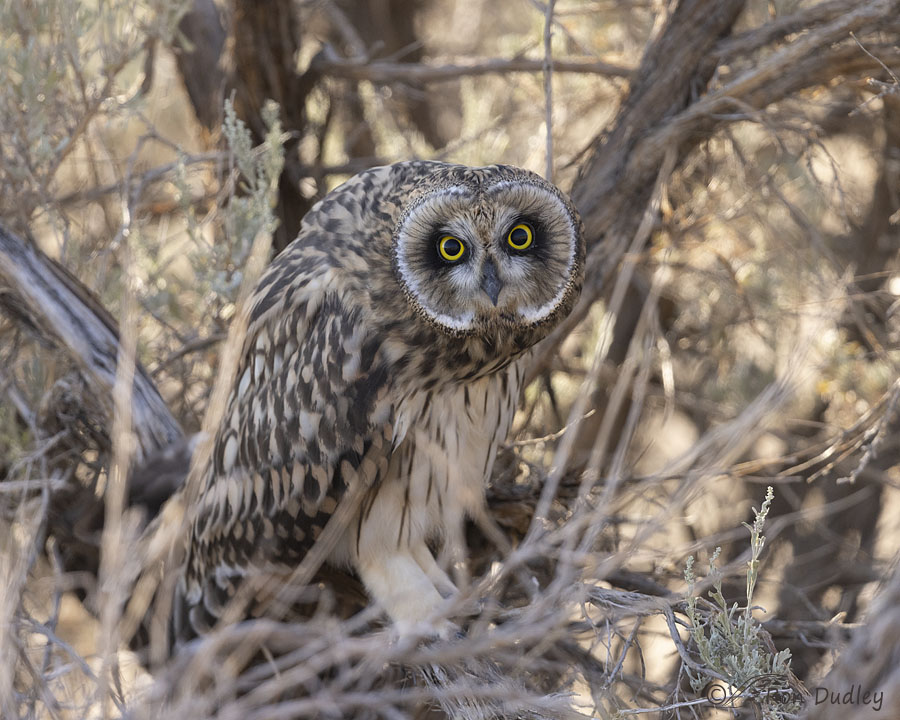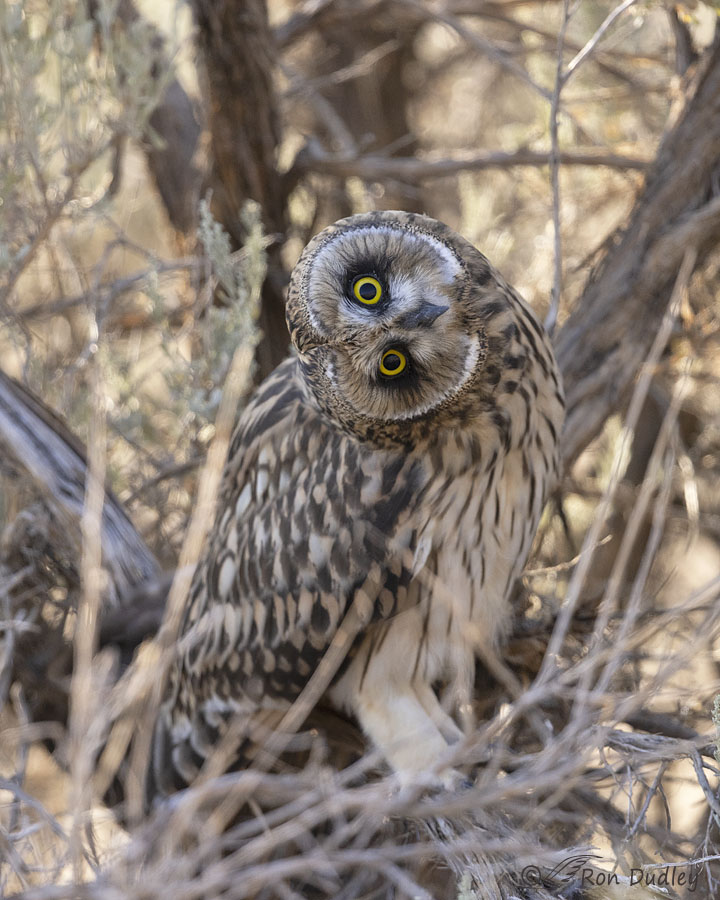Yesterday, while I was searching my photo organizer for a different photo of a different species, I mistakenly typed in the wrong image file number which brought up one of the photos I’d taken last summer of a recently fledged Short-eared Owl. Back then I’d posted a single photo of ‘him’ in the sagebrush he was perched in but my typing error reminded me that I had other shots of him, in different poses, that were also interesting.
These are two of them.

1/1600, f/5.6, ISO 1600, Canon R5, Canon EF500mm f/4L IS II USM + 1.4 tc, not baited, set up or called in
He was really buried in the sagebrush so the setting was cluttered and he was in shade but after maneuvering my pickup into position I had a pretty good look at him. He showed no fear or even nervousness, only curiosity. He was at least as interested in me as I was in him.

1/1600, f/5.6, ISO 1600, Canon R5, Canon EF500mm f/4L IS II USM + 1.4 tc, not baited, set up or called in
I got many photos of him parallaxing me and my pickup. In my book there aren’t many things more endearing than a baby or fledgling owl performing motion parallax.
Soon after these photos were taken I left the area while he was still in the sagebrush. When I returned 90 minutes later he was nowhere to be found.
Ron


They are so pretty and looking to see what is looking back at them. Wish I would see more owls around me. I hear them at night, but don’t see them during the day time, when they are sleeping or hiding.
Beyond cute!!!
Yup.
One or two more cervical vertebrae and I think I could parallax like that. Wouldn’t be cute, though; more like a bad horror movie.
I went to the ORI link and then to your Burrowing Owl link pointed out by Chris. The discussions there with Ken Britten and Harvey J. Marten were fascinating, if a bit (okay, a lot) over my head. So owls may be able to move their eyes in their sockets, and may use parallax for visual location or may be using it for sound location. My synapses are on overload.
” My synapses are on overload”
I had the same feeling when I read all that stuff years ago, Lyle. Since then I’d forgotten that they’d linked to my post and also forgotten the resulting discussion.
What lovely photos, what lovely birds. My heart bursts with joy at
the sight of these owls.
You are amazing.
Take Care,
Kaye
“You are amazing”
Owls MAKE me look good, Kaye.
What luck you should mistype and we get an adorable Short-eared Owl! I went to your ORI link (I’ve watched their Osprey webcam in Charlo for years), noticed they linked to a 2013 post of yours with lots of parallax info and truly wonderful photos of a young Burrowing Owl. So a twofer today, thanks!
Thanks for pointing out that link to my post, Chris. I hadn’t noticed it.
Awww. Total heart melters. Thank you. And for the link too.
You’re very welcome, EC. For both.
I’ll never get tired of seeing your Shorties! Thanks for sharing this morning!
Thank you, Diane.
Ron – A fledgling owl being adorable is the perfect antidote to the grey, rainy day happening outside. Thank you for these photos from your archives.
But even better, almost, is the link to the Owl Research Institute. Live owl cams for sleepless nights – what a treasure! Is that facility anywhere near your family’s Montana property?
“Is that facility anywhere near your family’s Montana property?”
Carolyn, I’d estimate that they’re about 150 miles apart. The Dudley farm is on the Blackfeet Reservation about 40 miles east of Glacier National Park. The Owl Research Institute is on the Flathead Reservation, near Charlo, southwest of Glacier NP.
I laughed out loud with that second image. Thanks for making my day!
Good. Thanks, Linda.
Thanks so much for these gorgeous and heartwarming shots. I’ll probably never get to see this live, but truly appreciate your sharing. It really brightens my day.
“I’ll probably never get to see this live”
I hope you do someday, Burrdoo. Guaranteed to make your day.
Ron, Thanks for the regular dose of great photos and your explanations. I learned a bit more about paralyzing today. I didn’t realize the owls couldn’t really move their eyes in their sockets as noted in the link you sent. I comment on your blog only rarely, but I enjoy reading it nearly every day. And I often learn something new.
Steve, there’s often additional valuable information in the links I provide. I’m delighted that you take advantage of them.
Like all of your posse, I couldn’t help myself uttering “awwww”– the only other species I know of which performs a similar move is domestic dogs, and the
effect on their humans is similar to that of the owls’ on everybody who sees it! What IS it, about that adorable querying twist of the head?
You’re spot on about dogs doing it too, Kris. All of the dogs I’ve had have done it. Regularly.
Thank you Ron for these (and all) your photos, they bring a smile every day. Ann
Much appreciated, Ann.
So very true! I was fortunate to discover a pair of Great Horned Owls nesting in a little-used greenspace near my home 2 years ago. I so enjoyed watching the little ones explore their world. Parallaxing really is the most adorable behaviour! Thanks for sharing these gorgeous “shortie” photos. What a delight!
Thanks very much, Sheila.
What a wonderful result from a mistyped number. Also, you mentioned “In my book…”
I’d really like to read that book someday Ron.
Thanks Mark but I don’t think “that book” is in the cards. It would be an incredible amount of work and I don’t have the ambition for it.
Not sure if that face could launch a thousands ships like Helen of Troy, but might attract a thousand Short-eared females?
Always enjoy your photos of these owls because I have never seen one in nature.
“might attract a thousand Short-eared females?”
Or a thousand bird photographers… Thanks, Everett.
Thanks, Everett.
Parallaxing IS one of the most endearing things young owls do…… Glad you were able to lock in on him AND nimble fingers yielded these rewards for us!
Glad you were able to lock in on him AND nimble fingers yielded these rewards for us!
Judy, I don’t know how nimble my fingers were but they didn’t have to be nimble because the little guy wasn’t moving much.